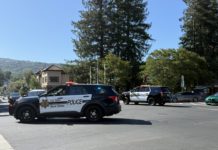
In the 30 days leading up to Nov. 9, 2022, in order to find 23 vehicles that might have been involved in a crime, the Flock Safety Automated License Plate Reader (ALPR) system scanned 458,411 plates, the Electronic Frontier Foundation found.
Since then, Los Gatos’ dragnet has increased significantly.
In the month prior to an Aug. 15 Council presentation, the Los Gatos-Monte Sereno Police Department says it scanned 601,133 vehicles—a jump of almost a third.
And the department has been eager to share elements of this dataset with its partners.
So, when Chief Jamie Field headed back to Council to share her summer crime update, she requested the leaders agree to loosen-up on a key digital data guardrail.
After a pilot program, Los Gatos signed on with Flock Safety at a cost of about $40,000 a year. This was OK’d through this year’s budget, which got multiple readings.
Now—just months after winning approval for the high-tech policing tool—Field was asking for Council members to flip the switch, in a single vote, on a major aspect of how it handles access to the millions of plates it scans every year.
“The data collected from this ALPR system is currently only being used by our agency and we are not sharing the information with other agencies within Santa Clara County; however, we are the only agency not sharing with other law enforcement agencies,” Field wrote in her report. “By allowing our agency to share this data with agencies within our County we will be increasing our ability to investigate and deter crime by broadening the data pool locally.”
Earlier this year, a LGMSPD Flock camera identified the vehicle it suspects was involved in a fatal hit-and-run collision, leading to the driver’s arrest, she added.
Councilmember Rob Rennie asked about how the police department stores the data, noting he’s aware Los Gatos’ policy is to destroy the information after 30 days.
He wondered what would happen to LGMSPD’s plate scans if it shared the data with an organization that’s allowed to hold on to data longer.
Rennie suggested it might be a good idea to limit sharing to organizations that keep data for an amount of time that’s within a range that Los Gatos officials are comfortable with.
“I wouldn’t want it to be indefinite,” Rennie said.
Det. Sgt. Bill Hoyt said while Los Gatos technically owns its data, it’s only accessing data that exists on a server somewhere.
Plus, police can only download data pursuant to a potential prosecution, he added.
Detective looked into every single vehicle that drove into Los Gatos in a half-hour period
When sharing information about a suspect vehicle, police are simply changing the permissions on who can view that very same data—not emailing or texting a dossier—he added.
“They don’t ever take our data in,” he said. “There’s no batch downloading that they need to delete.”
Councilmember Rob Moore asked for a few more specifics.
Hoyt replied with an example that was fresh on his mind: a business that had been broken into overnight. He said the cameras were helpful in responding to the crime.
“I love talking about the system. It’s incredible,” he said. “Almost all property crime is committed by people from out of town and they usually take a vehicle in.”
He was able to look at every single vehicle that entered town between 2:30 and 3am.
“There was 129 vehicles,” he said, noting after eliminating the garbage trucks and emergency vehicles it went down to 109.
About 20 seconds after a LGMSPD camera reader picks up the location, direction of travel and time of a particular plate in the Hot List database, all local police get an email and cellphone message, and dispatch is looped in.
“We’re able to flood that area and look for it,” Hoyt said. “Either a) we catch them…or 2, they take off from us. Now, most law enforcement agencies cannot chase non-violent criminals anymore, because of the huge risk during pursuits to the public. So, by having them flee, we know they came in; we know that vehicle’s been used in bad things before; we spotted them; they saw us; they think there’s probably 30 cops in Los Gatos, because four cops that are on duty—all four show up at the same place at the same time…we didn’t get to stop and catch them from doing bad things that night, or that day, but we stopped them from doing that here.”
Moore said because there are so many vehicles coming-and-going, that does appear to make it difficult to abuse the batch downloading system.
“If we do choose to share this, I think as AI gets more sophisticated and all that—and you can do more with filtering through large Excel spreadsheets and all that—I will be wanting to make sure that everyone who we’re sharing this with is still acting in good faith and not doing anything to batch download or anything like that,” he said.
Councilmember Matthew Hudes said ALPR technology isn’t about discriminating against any demographic group, but rather an attempt to zero in on actual offenders.
“This use of cameras and matching up with known criminals is the exact opposite of profiling,” he said. “This is not looking for general characteristics, but for finding the criminal that is looking to do bad things.”
Vice Mayor Mary Badame made the motion to share data with other Santa Clara County law enforcement agencies without placing any additional restrictions on the amount of time other jurisdictions can continue to hold on to plate info collected by Los Gatos.
It was approved unanimously.
The Flock Safety roll-out in Los Gatos was not the only one that was tweaked recently in Northern California.
The installation of license plate readers in Carmel-by-the-Sea was halted after some homeowners complained.
“They were putting new poles into the ground,” City Administrator Chip Rerig said Tuesday. “I stopped any additional installation.”
The Carmel Pine Cone newspaper reported that local residents have been worried about privacy issues and visual clutter near homes.
However, Rerig told the Los Gatan people were mostly having problems with the aesthetic aspect.
“The lion’s share of the concerns have not been the civil liberties,” he said, adding he’s been working behind the scenes to develop a plan to get the cameras—which have a solar panel attached—mounted on existing structures.
However, with Council members on vacation, any on-the-ground action is on pause.
The community grappled with the privacy questions back in 2018 when they signed up with a different vendor.
“We were worried about civil liberties issues at that time—and it was nothing,” he said, adding there are plenty of similarities between a community like Los Gatos and Carmel-by-the-Sea. “Generally, people have been supportive of an increased surveillance system.”
Having a powerful network that can share data about suspect vehicles in real-time has obvious benefits, he added.
“It will ping the neighboring jurisdiction,” he said, describing the functionality of the system. “If it’s a stolen plate from Los Gatos, it tells Los Gatos.”









